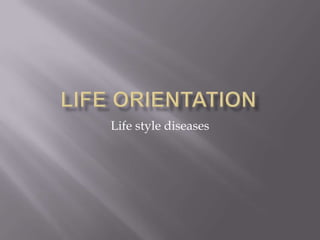
Life orientation(life style diseases)
- 2. An obese person has accumulated so much body fat that it might have a negative effect on their health. If a person's bodyweight is at least 20% higher than it should be, he or she is considered obese. If your Body Mass Index (BMI) is between 25 and 29.9 you are considered overweight. If your BMI is 30 or over you are considered obese.
- 4. Hypertension, also referred to as high blood pressure, is a condition in which the arteries have persistently elevated blood pressure. Every time the human heart beats, it pumps blood to the whole body through the arter
- 6. Cancer is a class of diseases characterized by out-of-control cell growth. There are over 100 different types of cancer, and each is classified by the type of cell that is initially affected. Cancer harms the body when damaged cells divide uncontrollably to form lumps or masses of tissue called tumors (except in the case of leukemia where cancer prohibits normal blood function by abnormal cell division in the blood stream). Tumors can grow and interfere with the digestive, nervous, and circulatory systems, and they can release hormones that alter body function. Tumors that stay in one spot and demonstrate limited growth are generally considered to be benign.
- 8. stroke occurs when blood flow is interrupted to a part of the brain, either when an artery bursts or becomes closed when a blood clot lodges in it. Blood circulation to the area of the brain served by that artery stops at the point of disturbance, and the brain tissue beyond that is damaged or dies. (Brain cells need blood to supply oxygen and nutrients and to remove waste products.) Depending on the region of the brain affected, a stroke can cause paralysis, loss of vision, speech impairment, memory loss and reasoning ability, coma, or death.
- 10. Human Immunodeficiency Virus (HIV) is a viral disease that enters the body and infects the white blood cells of the immune system. If the immune system is infected, the body cannot protect itself from other viruses and infections. When infected by HIV, the body is vulnerable to diseases that would not be a problem if the infected person were healthy. The diseases that would not affect a healthy person could cause a person infected with HIV to become very ill or could even cause death.
- 12. There are many kinds of heart disease, and they can affect the heart in several ways. But the ultimate problem with all varieties of heart disease is that, in one way or another, they can disrupt the vital pumping action of the heart.
- 14. Arthritis affects the musculoskeletal system, specifically the joints. It is the main cause of disability among people over fifty-five years of age in industrialized countries.